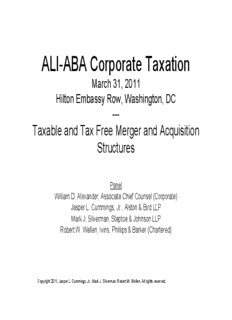
ALI-ABA Corporate Taxation - Steptoe & Johnson LLP PDF
Preview ALI-ABA Corporate Taxation - Steptoe & Johnson LLP
ALI-ABA Corporate Taxation March 31, 2011 Hilton Embassy Row, Washington, DC --- Taxable and Tax Free Merger and Acquisition Structures Panel William D. Alexander, Associate Chief Counsel (Corporate) Jasper L. Cummings, Jr., Alston & Bird LLP Mark J. Silverman, Steptoe & Johnson LLP Robert W. Wellen, Ivins, Phillips & Barker (Chartered) Copyright 2011, Jasper L. Cummings, Jr.; Mark J. Silverman; Robert W. Wellen. All rights reserved. Subjects • Administration Budget Proposals in Corporate Tax • Taxable Acquisitions – Intermediary Transactions – Rescission – Ralph’s – Contingent Purchase Price Issues – Other Cases of Note (Flextronics, MediaSpace) • Tax-Free Acquisitions – Reg. 1.368-2(k) – Step Transaction Issues – Liquidation / Reincorporation – “D” Reorganizations – Nonqualified Preferred Stock 2 Reg. § 1.1502-13(c)(6)(ii) (3/3/2011) • Limitation on treatment of intercompany items as excluded from gross income: Notwithstanding the attribute redetermination rule of Reg. § 1502-13(c)(1)(i), S's intercompany income or gain is redetermined to be excluded from gross income only to the extent one of the following applies: – (A) B's corresponding item is a deduction or loss and, in the taxable year the item is taken into account under this section, it is permanently and explicitly disallowed under another provision of the Internal Revenue Code or regulations. – (B) The corresponding item is a loss that is realized, but not recognized under section 311(a) on a distribution to a nonmember (even though the loss is not a permanently and explicitly disallowed amount within the meaning of paragraph (c)(6)(ii)(A) of this section). – (C) The Commissioner determines that treating S’s intercompany item as excluded from gross income is consistent with the purposes of this section and other applicable provisions of the Internal Revenue Code and regulations. 33 Example – Bust-Up Transaction $40 P X P X Liquidate ③ ② FMV -$60 FMV -$40 FMV -$100 AB -$0 AB -$40 AB -$100 W W ① T Assets T FMV -$40 Distribute FMV -$60 AB -$0 FMV -$40 AB -$0 AB -$0 W U U •In Year 1, P buys T for $100. T owns 100% of •T has a $60 section 311(b) intercompany gain Unwanted (U) with a $0 basis and $40 value and upon the distribution of W to P. 100% of Wanted (W) with a $0 basis and $60 • If the $60 gain is eliminated upon W’s section value. 332 liquidation, P could sell T without the • Step 1: In Year 2, T distributes the W stock to recognition of gain or loss. P. • Step 2: In Year 3, W liquidates into P in a section 332 transaction. • Step 3: In Year 4, P sells T to X, a third party for $40. 44 Administration 2012 Budget Proposal • Repeal “boot dividend within gain” limitation in §356(a) • Repeal provisions relating to “nonqualified preferred stock” for stock issued after 12/31/2011 (General Explanation, p. 88). – Loss recognition transaction • Must mean transaction that would be under sec. 351 but for the fact that NO stock is received – To avoid related party rules in 304? 5 Administration Budget Proposals • CCA 201025046: P P sells DS stock to FS for NQP And claims loss, deferred By 267 until DS liquidates. Loss in DS stock FS DS 6 Administration Budget Proposals • LTR cont’d – The CC (Corp) cogently explained why the taxpayer would not obtain the loss recognition under the matching rule and section 267. – Why does the Treasury want to throw out the baby with the bath water? (assuming there ever was a baby in 351(g)? – Why did not Treasury every undertake to write regulations under 351(g)? 7 Administration Budget Proposals FP C/S D1 stock or Note or NQPS Basis = $0 Basis = $0 D1 D2 FMV = $60 FMV = $40 E&P = $25 E&P = $25 FP, a foreign corporation, owns all the stock of domestic corporations D1 and D2, all common stock. FP’s basis in both the D1 stock and the D2 stock is $0. D1 stock FMV is $60. D2 stock FMV is $40. D1 and D2 each has $25 E&P. FP transfers the D1 stock to D2— - For additional D2 common stock (or as a capital contribution for no consideration) - For a $60 D2 note - For D2 nonqualified preferred stock ($60 FMV) What is D2’s basis in the D1 stock? 8 Taxable Acquisitions • Intermediary Transactions • Rescission • Ralph’s • Contingent Purchase Price Issues • Other Cases of Note 9 Intermediary Transactions: Notices 2001-16, 2008-20 & 2008-111 Corporation T owns Asset with $0 X M Y basis and $100 value. T has no other property, debt or tax attributes. X (classification does not matter) owns all the stock of T with $80 AB = $80 FMV = $80 $100 basis. Because of T’s $0 basis in Asset, the fair market value of the T Built-in Loss stock is $80. T Corporation M has a $100 built-in loss tax attribute. AB = $0 Y (classification does not matter) FMV = $100 wants to acquire Asset. Y is willing to pay $100 for Asset with a cost basis or $80 for the T stock or for Asset Asset with a $0 basis. 10
Description: